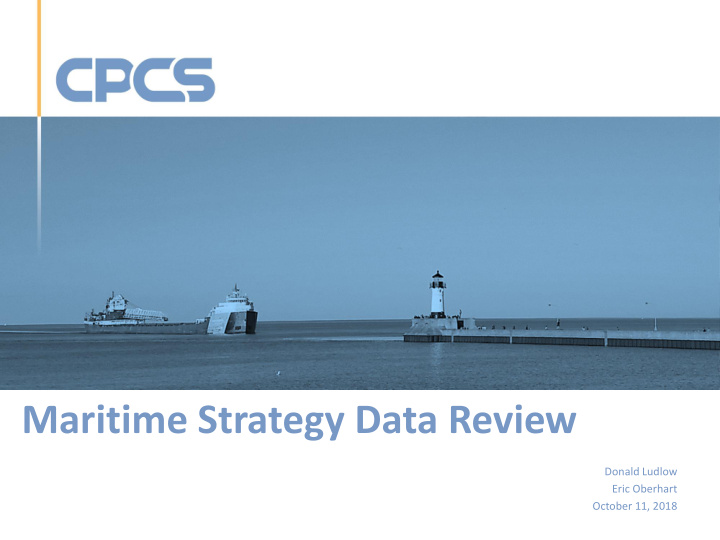



Maritime Strategy Data Review Donald Ludlow Eric Oberhart October 11, 2018
Presentation Map Background and Objectives of Report Major Findings Recommendations Discussion 2
Project Objective Provide Blue Accounting with recommendations on data sources for maritime transportation performance measurement for the Great Lakes and St. Lawrence System. Data to measure progress toward the Maritime Transportation System (MTS) Strategy’s 3 Goals: 1. Double maritime trade 2. Shrink the environmental impact of the transportation network 3. Support the region’s industrial core Source: GSGP 3
Measure Categories from MTS Categories from “Delivering Results and Managing for the Future” MTS Strategy Objective: Freight volume Freight value Environmental performance Employment and taxes Investment Value creation System performance 4
Data Selection Guidelines Data selections oriented to facilitate: • “Quick start” of measurement in next 6 -9 months. • Sustainable long-term measurement in future. • Readily available • Free or inexpensive • Real, not modeled • Updated frequently • Up-to-date 5
Report Format 1. Guidance for initial measure development – Data sources and gaps for goals and categories – Recommendations for future work 2. Data profiles for future reference – Reference information on key data sources – List of other sources reviewed Report does not: • Comprehensively list all data relevant to GLSLS. • Evaluate performance measures. Data evaluation only. • Put bounds on future data collection or measures. 6
Presentation Map Background and Objectives of Report Major Findings Recommendations Discussion 7
Data Sources, Providers, and Categories Value Creation Environment Performance Employment Investment Volume Value Data Source: Provider: Automatic Identification System Canadian and US Coast Guards X X Canada Port Authority Annual Reports Transport Canada X X Canadian Business Counts StatCan X Canadian International Merchandise Trade StatCan X X County Business Patterns US Census Bureau X Dredging Information System US Army Corps of Engineers X Employment by Industry StatCan X Federal Reserve Economic Data US Federal Reserve X GDP by Province and Industry StatCan X Incident Investigation Reports US Coast Guard X X Pilotage Association Annual Reports Great Lakes Pilotage Association X X Great Lakes Water Level US Army Corps of Engineers X Green Marine Annual Performance Report Green Marine X INNAV Canadian Coast Guard X X Lake Carriers’ Association Dry Bulk Data Lake Carriers’ Association X Lock Performance Monitoring System US Army Corps of Engineers X Marine Safety Information System Transportation Safety Board (CA) X X National Response Center Reports US Coast Guard X X Occupational Employment Statistics US Bureau of Labor Statistics X Seaway Development Corporation X X St. Lawrence Seaway Annual Reports Seaway Management Corporation X X X TransBorder Freight Data US Bureau of Transportation Statistics X X Waterborne Commerce Statistics US Army Corps of Engineers X 8
Data Availability Category Data Types and Availability Tonnage: All US ports, Soo Locks, Seaway. Freight Volume Vessel Trips: All GLSLS, Soo Locks, Seaway. Freight Value US and Canadian imports and exports. Incidents and Spills: All GLSLS Environment Green Marine Participation: select ports, vessel operators Establishment and employment counts: all US and CAN Employment Labor productivity: Canadian provinces Port Investments: select Canadian and US ports Investment Dredging: US ports Lock and Dam: Soo Locks and Seaway. Value Creation GDP for Canada and the US System Reliability, Safety, Season Length, Travel Time, Bottlenecks Performance 9
Major Challenges Two major challenges prevent us from getting a “full view” of the GLSLS maritime transportation system. • Fragmented management of system. • Historically, limited collection or release of data. Source: Worldportsource.com 10
Major Gaps Identifying and overcoming the asymmetry of maritime data between the US and Canada will be important to improving GLSLS performance measurement in the future. Topic Gaps Noted Freight Volume Canada has limited tonnage data after 2011. Freight Value No data on value of domestic movements. Incidents and Spills US incident data quality is lower for post-2015. Taxes No unified tax collection or disbursement data. Infrastructure Condition Lack of easily-usable channel dimension data. Pilotage Limited data on performance of US pilotage system. Investment Data fragmented between locations. Value Creation Limited granularity of data. 11
Presentation Map Background and Objectives of Report Major Findings Recommendations Discussion 12
Performance Measurement Best Practices Transportation system performance measures should be “SMART”— Specific, Measurable, Attainable, Realistic, and Timely. • Measure what matters • Select a limited set of measures • Measures should be feasible to report Source: Eric Oberhart 13
Next Steps (Near Term) • Focus on limited number of measures. • Link each new measure to the MTS’ three key goals • Confirm geographic boundaries • Consider measuring at select ports/locations • Explore partnership with the Maritime Information System Source: Maritime Information System 14
Long Term Recommendations • Develop relationships with data-producing agencies. • Continue creating in-depth system studies. Source: Eric Oberhart 15
Presentation Map Background and Objectives of Report Major Findings Recommendations Discussion 16
Questions & Discussion Donald Ludlow Project Director dludlow@cpcstrans.com Eric Oberhart Project Manager eoberhart@cpcstrans.com 17
Recommend
More recommend